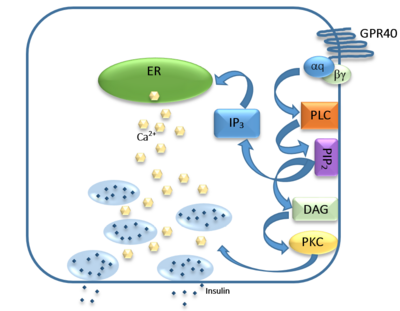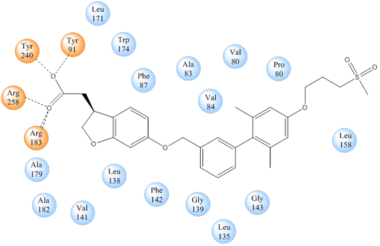User:Brittany Stankavich/Sandbox 1
From Proteopedia
(Difference between revisions)
| Line 12: | Line 12: | ||
== Function == | == Function == | ||
| - | GPR40 is most prevalent in [https://en.wikipedia.org/wiki/Beta_cell pancreatic β-cells] where free fatty acids (FFAs) have pleiotropic effects. While acute intake of FFAs stimulates insulin release, chronic exposure to high levels of FFAs results in the impairment of β-cell function and insulin secretory response. GPR40 mediates the effect of both acute and chronic levels of FFAs. FFAs amplify glucose-stimulated insulin secretion from pancreatic β-cells by activating GPR40. | + | GPR40 is most prevalent in [https://en.wikipedia.org/wiki/Beta_cell pancreatic β-cells] where free fatty acids (FFAs) have pleiotropic effects <ref name="FFA">PMID:19460454</ref>. While acute intake of FFAs stimulates insulin release, chronic exposure to high levels of FFAs results in the impairment of β-cell function and insulin secretory response <ref name= "FFA"/>. GPR40 mediates the effect of both acute and chronic levels of FFAs. FFAs amplify glucose-stimulated insulin secretion from pancreatic β-cells by activating GPR40. |
| - | When GPR40 is inhibited, insulin secretion no longer increases in response to fatty acid stimulation. This decreased activity of GPR40 leads to a decreased risk of [https://en.wikipedia.org/wiki/Hyperinsulinemia hyperinsulinemia], [https://en.wikipedia.org/wiki/Fatty_liver fatty liver disease], [https://en.wikipedia.org/wiki/Hypertriglyceridemia hypertriglyceridemia], [https://en.wikipedia.org/wiki/Hyperglycemia hyperglycemia], and [https://en.wikipedia.org/wiki/Impaired_glucose_tolerance glucose tolerance] in obese patients. On the contrary, overexpression of GPR40 leads to impaired β-cell function, hyperinsulinemia, and diabetes. These results suggest that GPR40 plays an important role in the mechanism that links obesity and type 2 diabetes and thus is a popular drug target being studied. | + | When GPR40 is inhibited, insulin secretion no longer increases in response to fatty acid stimulation <ref name= "FFA"/>. This decreased activity of GPR40 leads to a decreased risk of [https://en.wikipedia.org/wiki/Hyperinsulinemia hyperinsulinemia], [https://en.wikipedia.org/wiki/Fatty_liver fatty liver disease], [https://en.wikipedia.org/wiki/Hypertriglyceridemia hypertriglyceridemia], [https://en.wikipedia.org/wiki/Hyperglycemia hyperglycemia], and [https://en.wikipedia.org/wiki/Impaired_glucose_tolerance glucose tolerance] in obese patients <ref name= "FFA"/>. On the contrary, overexpression of GPR40 leads to impaired β-cell function, hyperinsulinemia, and diabetes <ref name= "FFA"/>. These results suggest that GPR40 plays an important role in the mechanism that links obesity and type 2 diabetes and thus is a popular drug target being studied. |
== Signal Transduction == | == Signal Transduction == | ||
| Line 29: | Line 29: | ||
=== Free Fatty Acids === | === Free Fatty Acids === | ||
| - | GPR40’s natural substrate are FFAs in which a free [https://en.wikipedia.org/wiki/Carboxylic_acid carboxyl group] is required to bind. However, GPR40 can be activated by a wide variety of fatty acids with chain lengths ranging from [https://en.wikipedia.org/wiki/Saturated_fat saturated fatty acids] with 8 carbons to 23 carbons. In addition, various [https://en.wikipedia.org/wiki/Monounsaturated_fat mono] (i.e. [https://en.wikipedia.org/wiki/Palmitoleic_acid palmitoleic] (C16:1) and [https://en.wikipedia.org/wiki/Oleic_acid oleic] (C18:1) acids) and [https://en.wikipedia.org/wiki/Polyunsaturated_fatty_acid poly-unsaturated fatty acids] (i.e.[https://en.wikipedia.org/wiki/Linoleic_acid linoleic] (C18:2) and [https://en.wikipedia.org/wiki/List_of_unsaturated_fatty_acids#Eicosatrienoic_acid eicosatrienoic] (C20:3) acids) can activate GPR40 <ref name= "Morg">. The agonists potency varies according to the carbon-chain length however. The activity of GPR40 increases when the chain is increased from C6 to C15 but then decreased when the chain was extended beyond C15. One explanation for this is that as [https://en.wikipedia.org/wiki/Alkyl alkyl] chain increased, so did the [https://en.wikipedia.org/wiki/Hydrophobe hydrophobic] interactions with the protein within the binding pocket. However, for FFAs with carbon chains longer than C15, the molecular size is too large for the binding pocket. This causes the alkyl chain to extend beyond the binding pocket and destabilize the binding <ref name="Ren">PMID:26974599</ref>. | + | GPR40’s natural substrate are FFAs in which a free [https://en.wikipedia.org/wiki/Carboxylic_acid carboxyl group] is required to bind. However, GPR40 can be activated by a wide variety of fatty acids with chain lengths ranging from [https://en.wikipedia.org/wiki/Saturated_fat saturated fatty acids] with 8 carbons to 23 carbons. In addition, various [https://en.wikipedia.org/wiki/Monounsaturated_fat mono] (i.e. [https://en.wikipedia.org/wiki/Palmitoleic_acid palmitoleic] (C16:1) and [https://en.wikipedia.org/wiki/Oleic_acid oleic] (C18:1) acids) and [https://en.wikipedia.org/wiki/Polyunsaturated_fatty_acid poly-unsaturated fatty acids] (i.e.[https://en.wikipedia.org/wiki/Linoleic_acid linoleic] (C18:2) and [https://en.wikipedia.org/wiki/List_of_unsaturated_fatty_acids#Eicosatrienoic_acid eicosatrienoic] (C20:3) acids) can activate GPR40 <ref name= "Morg"/>. The agonists potency varies according to the carbon-chain length however. The activity of GPR40 increases when the chain is increased from C6 to C15 but then decreased when the chain was extended beyond C15. One explanation for this is that as [https://en.wikipedia.org/wiki/Alkyl alkyl] chain increased, so did the [https://en.wikipedia.org/wiki/Hydrophobe hydrophobic] interactions with the protein within the binding pocket. However, for FFAs with carbon chains longer than C15, the molecular size is too large for the binding pocket. This causes the alkyl chain to extend beyond the binding pocket and destabilize the binding <ref name="Ren">PMID:26974599</ref>. |
FFAs bind to hGPR40 by coordinating its free carboxyl group to three amino acids, <scene name='72/727085/Ffa_binding/1'>Arg183, Tyr2240, and Arg258</scene>, which are located close to the <scene name='72/727085/Hgpr40_transmembrane/2'>extracellular domains</scene> of hGPR40 on TM5, 6 and 7. Because of the close proximity of these <scene name='72/727085/Hgpr40_transmane_active/1'>residues</scene> to the extracellular domain and the dominantly hydrophobic nature of FFA’s, it is possible that ligand binding occurs close to, or within, the plane of the membrane <ref name="Morg">PMID:19660440</ref>. | FFAs bind to hGPR40 by coordinating its free carboxyl group to three amino acids, <scene name='72/727085/Ffa_binding/1'>Arg183, Tyr2240, and Arg258</scene>, which are located close to the <scene name='72/727085/Hgpr40_transmembrane/2'>extracellular domains</scene> of hGPR40 on TM5, 6 and 7. Because of the close proximity of these <scene name='72/727085/Hgpr40_transmane_active/1'>residues</scene> to the extracellular domain and the dominantly hydrophobic nature of FFA’s, it is possible that ligand binding occurs close to, or within, the plane of the membrane <ref name="Morg">PMID:19660440</ref>. | ||
Revision as of 00:54, 21 April 2016
- User:Brittany Stankavich/Sandbox 1
hGPR40 Homo sapiens
| |||||||||||
References
- ↑ Ren XM, Cao LY, Zhang J, Qin WP, Yang Y, Wan B, Guo LH. Investigation of the Binding Interaction of Fatty Acids with Human G Protein-Coupled Receptor 40 Using a Site-Specific Fluorescence Probe by Flow Cytometry. Biochemistry. 2016 Mar 17. PMID:26974599 doi:http://dx.doi.org/10.1021/acs.biochem.6b00079
- ↑ 2.0 2.1 2.2 2.3 2.4 Ichimura A, Hirasawa A, Hara T, Tsujimoto G. Free fatty acid receptors act as nutrient sensors to regulate energy homeostasis. Prostaglandins Other Lipid Mediat. 2009 Sep;89(3-4):82-8. doi:, 10.1016/j.prostaglandins.2009.05.003. Epub 2009 May 19. PMID:19460454 doi:http://dx.doi.org/10.1016/j.prostaglandins.2009.05.003
- ↑ 3.0 3.1 3.2 Morgan NG, Dhayal S. G-protein coupled receptors mediating long chain fatty acid signalling in the pancreatic beta-cell. Biochem Pharmacol. 2009 Dec 15;78(12):1419-27. doi: 10.1016/j.bcp.2009.07.020., Epub 2009 Aug 4. PMID:19660440 doi:http://dx.doi.org/10.1016/j.bcp.2009.07.020
- ↑ Ren XM, Cao LY, Zhang J, Qin WP, Yang Y, Wan B, Guo LH. Investigation of the Binding Interaction of Fatty Acids with Human G Protein-Coupled Receptor 40 Using a Site-Specific Fluorescence Probe by Flow Cytometry. Biochemistry. 2016 Mar 17. PMID:26974599 doi:http://dx.doi.org/10.1021/acs.biochem.6b00079
- ↑ Hanson MA, Roth CB, Jo E, Griffith MT, Scott FL, Reinhart G, Desale H, Clemons B, Cahalan SM, Schuerer SC, Sanna MG, Han GW, Kuhn P, Rosen H, Stevens RC. Crystal structure of a lipid G protein-coupled receptor. Science. 2012 Feb 17;335(6070):851-5. PMID:22344443 doi:10.1126/science.1215904
- ↑ Li X, Zhong K, Guo Z, Zhong D, Chen X. Fasiglifam (TAK-875) Inhibits Hepatobiliary Transporters: A Possible Factor Contributing to Fasiglifam-Induced Liver Injury. Drug Metab Dispos. 2015 Nov;43(11):1751-9. doi: 10.1124/dmd.115.064121. Epub 2015, Aug 14. PMID:26276582 doi:http://dx.doi.org/10.1124/dmd.115.064121
- ↑ 7.0 7.1 Takano R, Yoshida M, Inoue M, Honda T, Nakashima R, Matsumoto K, Yano T, Ogata T, Watanabe N, Hirouchi M, Yoneyama T, Ito S, Toda N. Discovery of DS-1558: A Potent and Orally Bioavailable GPR40 Agonist. ACS Med Chem Lett. 2015 Jan 13;6(3):266-70. doi: 10.1021/ml500391n. eCollection, 2015 Mar 12. PMID:25815144 doi:http://dx.doi.org/10.1021/ml500391n


